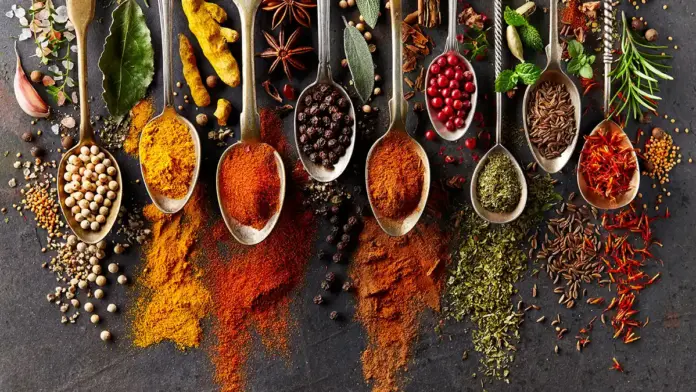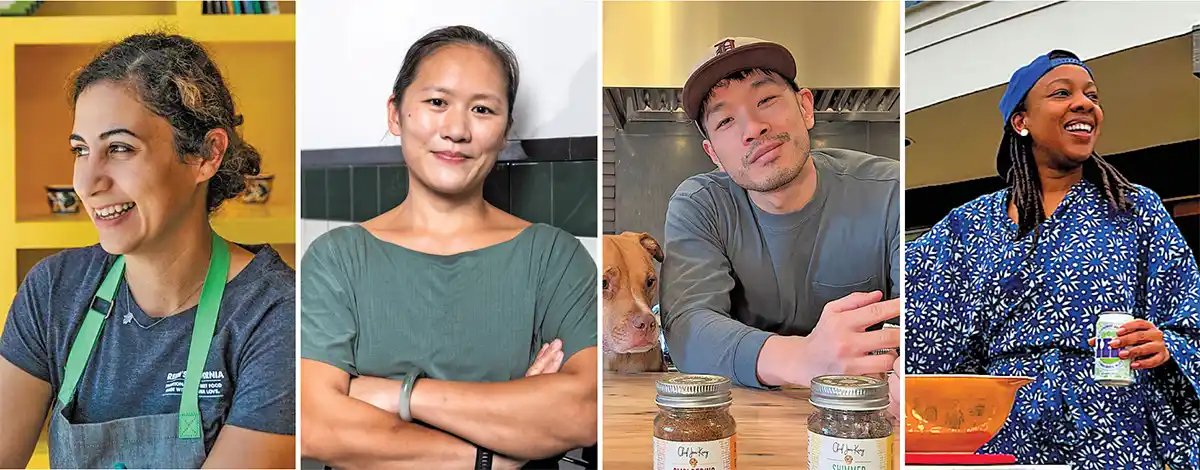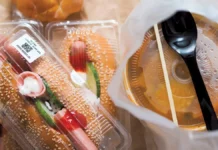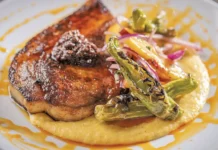
How can Chefs meet the demand for flavor? It’s back to basics and that means selecting spices that challenge the status quo. Chef Reem Assil, Reem’s California in San Francisco, CA; Co-Founder and Chef Connie Chung, Milu, New York, NY; Chef Jon Kung, Detroit, MI; Chef Ashleigh Shanti, Good Hot Fish, Asheville, NC; along with Ethan Frisch, Co-Founder and Co-CEO of Burlap & Barrel share their insights and trends for Spring 2023.
According to Ethan Frisch, “I started my spice education as a line cook at Tabla, working under the late, brilliant Chef Floyd Cardoz, so Burlap & Barrel has always had close connections to the restaurant industry and we love supplying chefs with their most flavorful ingredients! Chefs were our first customers when Ori and I started the company, and have always been like an informal R&D team, giving us feedback and making requests for spices they’d like to see us source. Over the past year, we’ve had the opportunity to work more closely with some especially inspiring chefs to create their signature spice blends, helping introduce their unique flavors to home cooks who might not be able to visit their restaurants in person. A spice blend is an incredible way to encapsulate a chef’s culinary style and connect it to the traditional cuisines that inspire them, and we love the creative challenge of adapting and scaling those personal recipes to get them onto market shelves and into home kitchens across the country.”

Are you noticing any shifts in chefs using spices?
Chef Reem Assil: Definitely seeing a lot more use of sumac and za’atar and aleppo pepper on menus. People are leaning towards spices from Southwest Asia and North America more than I’ve seen in the past.
Chef Connie Chung: Definitely. With so many dining choices out there, chefs are looking for new and different ways to stand out. I think that utilizing new or lesser-known spices is one great way to do that.
Chef Jon Kung: I’m noticing a wider acceptance to using spices and being more educated in spices overall by the general public. Generally, POC chefs have always been immersed the use of spices particularly South Asian and Chinese Chefs. What I’d like to see is more interchange of methodology between cultures in how they use their spices, particularly cultures with deep histories of using them.
Chef Ashleigh Shanti: I’ve noticed spices being widely used in more nontraditional ways. Beyond proteins, I’m seeing spices make their way onto popcorn, nuts and even desserts.
What are some of the challenges facing chefs using spices?
Assil: I think it’s hard to source good spices that are affordable but really premium. With the cost of everything going up, this makes the challenge even harder. So then other factors have to come into play to help chefs make sure their investment is worth it.
Chung: Just as with other aspects of cooking, it’s always about balance. You want the spice(s) to be apparent but also not overpowering.
Kung: Sourcing, the pandemic has taught us that the world’s shipping routes hang in a delicate balance and even when things are fine, ethical sourcing is also difficult. Luckily, we have brands who have that built into their ethos making it easy for cooks to make more informed decisions. Sourcing is also a factor that affects potency and freshness which is the entire point of whole natural spices.
Shanti: The biggest challenge in sourcing spices is ensuring they’re ethically sourced and that those spices are making into your hands at their freshest
How is B&B an important partner in the chef’s menu process?
Assil: B&B has always been attentive to the chefs needs since they have firsthand experience in the industry. They are generous and let you sample a lot to find the right fit of their spices with the flavor profiles of your food. They are master foragers and only bring us the best quality spices.
Chung: What’s great about B&B is they bring spices with profiles that are super unique. For example, I was previously never a great fan of cumin. I always found it overpowering. But the Wild Mountain Cumin is softly aromatic but still super flavorful. These new flavors can be super inspiring when working on new menu ideas.
Kung: A chef values reliability more than any other thing in the kitchen whether it be from their staff, their vendors, or their ingredients. Enough things go wrong in a restaurant that any source of stability is a welcome addition to the workflow. B&B delivers quality with consistency which is the foundation of their value.
Shanti: I choose spices for a dish to enhance and compliment my food. B&B has a reputation of delivering spices at their peak flavor making the menu planning a breeze.
There’s a shift in the way consumers are eating, how are you using spices today?
Assil: Less is more– I find that spices for garnish go a long way the B&B spices are so beautiful and fragrant that seeping them in oils or simply sprinkling them on top goes a long way!
Chung: It’s a lot about blends these days, and again balance. Just using one spice is too “one level.” It’s a great way to elevate flavor, and interest, by using a combination of spices.
Kung: As a Chinese American chef, the shift is towards me. My cooking has been constant but curiosity of the public at large and the desire to allow POC Chefs and Cooks to speak for and represent themselves is opening more minds to our cuisine. We are not changing anything, we are the change.
Shanti: Spice-forward food has always been my thing. Nowadays, I find myself finding more creative ways to insert fun spices throughout every element of a dish.
Which spice(s) are you planning to use for your Spring dishes?
Assil: Cured sumac, za’atar, silik chili, khalta harra
Chung: We use a blend of coriander, fennel, and cumin for our cauliflower dish. And white pepper, five spice, and garlic powder in our new meatball dish. We also use a blend of black urfa chili, silk chili, cobanero chili, coriander, cumin, fennel, cardamom, and black pepper in our chili crisp.
Kung: Coming from Michigan, I look forwards to garlic scapes, morels, radishes, and heirloom greens. Ramps if they’re sourced ethically. Spring in Michigan really is the starter course of the farming season. It’s all about the summer and fall here. So with these I would say my Shimmer Salt with B&B to bring out the brightness of greens and Earthy cumin and cumin based blends for mushrooms with butter.
Shanti: This Spring, I’ll be leaning into rubs and blends for grilled proteins like my Kitchen Pepper. With warmer temps come more opportunities to highlight produce and allow them to shine using single ingredient spices like sumac or coriander.
Are you using spice blends to create menus that introduce customers to unique dishes?
Chung: Five spice is by no means a new mix, or unique to B&B but it is not a well-loved mix. It tends to be overpowering. But B&B’s five spice blend is subtle and still super flavorful. We are using it in our new meatball bowl for the spring as well as in an oatmeal cookie.
Kung: I’m creating the spice blends themselves. This year I came up with three blends with B&B to introduce people to blends rooted in Chinese flavors that are versatile enough to use in their own cooking with the goal of adding unexpected elements to dishes they already make at home.
Shanti: Yes, spice blends are not only convenient to utilize but they offer complexity and depth to the simplest of ingredients.
What’s on your Spring Menu?
Assil: Spring Fattoush Salad with fava beans, spring radish, and green garlic, man’oushe with lemon garlic sauce, akkawi cheese, charred asparagus, sumac onions, and zaatar and herbed breadcrumbs; swiss chard tahini dip (mutabal salak)
Chung: We have a new meatball dish inspired by a traditional Chinese dish – lion’s head meatball, frequently served at dim sum. We season our meatball mix with white pepper, five spice, and garlic powder. The meatballs are glazed with a soy ginger sauce. And then served with charred asparagus tossed in a roasted garlic sauce. We also have, new to the menu, five spice oatmeal cookies with ginger buttercream.
Kung: First season greens and still a lot of soups and curries because spring here is still “comfort food cold”.
Shanti: I’ve got some events and pop ups on my Spring calendar where I’ll highlight Good Hot Fish’s Kitchen Pepper wings. I also have plans for a simple dish of roasted fruits wrapped in banana leaf spiced with chili flake and sea salt.
Purchasing information: Chefs can email Burlap & Barrel at wholesale@burlapandbarrel.com for samples and ordering information.























